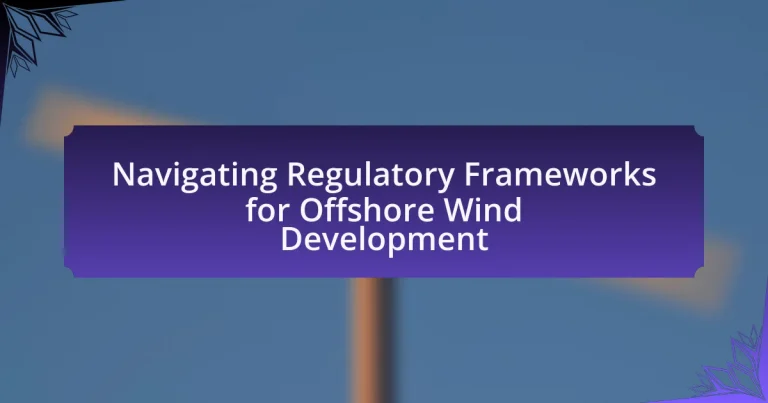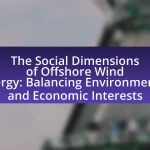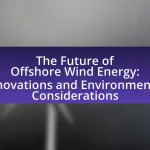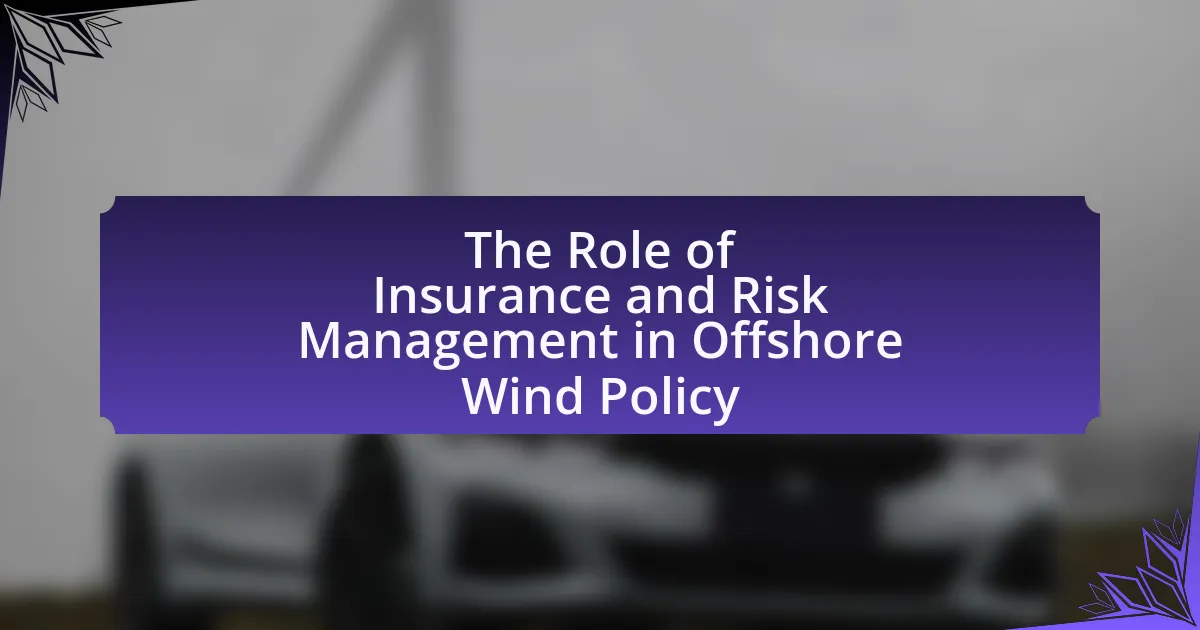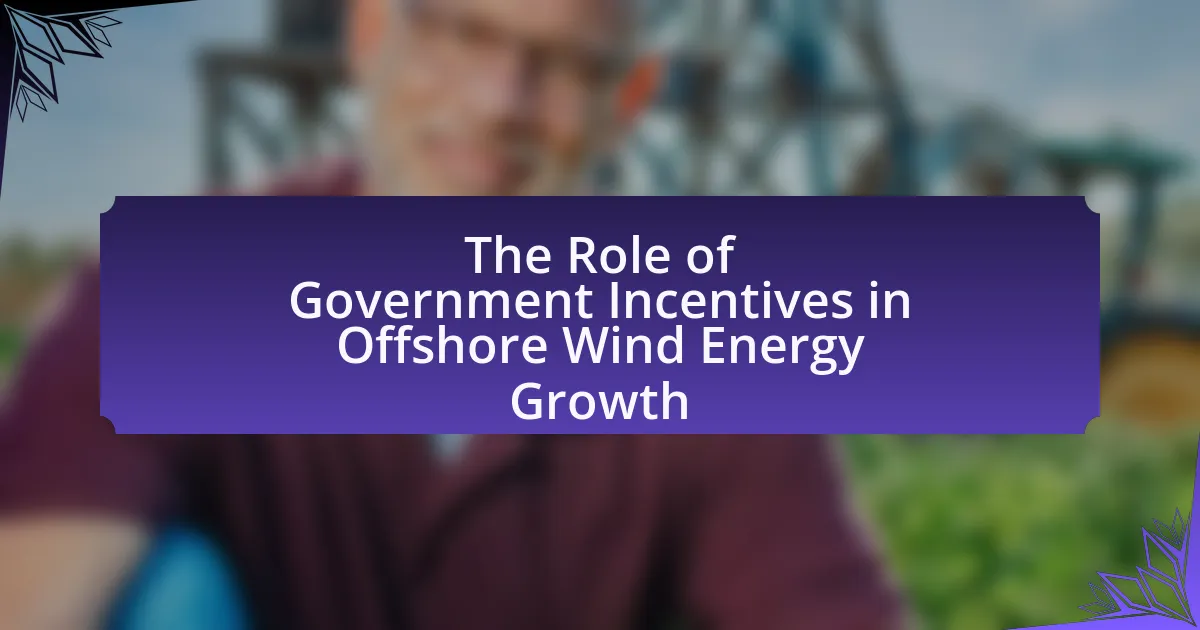The article focuses on navigating regulatory frameworks for offshore wind development, highlighting key regulations such as the National Environmental Policy Act (NEPA), the Outer Continental Shelf Lands Act (OCSLA), and the Clean Water Act (CWA). It examines the impact of international agreements like the Paris Agreement and the European Union’s Renewable Energy Directive on national policies and project feasibility. The article also addresses the challenges developers face, including complex permitting processes and stakeholder engagement, while outlining best practices for compliance and successful project execution. Additionally, it emphasizes the importance of environmental assessments and community involvement in streamlining regulatory processes.
What are the key regulatory frameworks for offshore wind development?
The key regulatory frameworks for offshore wind development include the National Environmental Policy Act (NEPA), the Outer Continental Shelf Lands Act (OCSLA), and the Clean Water Act (CWA). NEPA requires federal agencies to assess the environmental impacts of their proposed actions, including offshore wind projects, ensuring that potential effects on marine ecosystems are considered. OCSLA governs the leasing of federal waters for offshore energy development, establishing a process for obtaining permits and conducting environmental reviews. The CWA regulates discharges into navigable waters, which is crucial for managing the water quality impacts of offshore wind installations. These frameworks collectively ensure that offshore wind development is conducted in an environmentally responsible manner while facilitating the growth of renewable energy sources.
How do international regulations impact offshore wind projects?
International regulations significantly impact offshore wind projects by establishing standards for environmental protection, safety, and operational procedures. These regulations, such as the European Union’s Renewable Energy Directive and the International Maritime Organization’s guidelines, dictate compliance requirements that developers must follow to secure permits and funding. For instance, adherence to the Environmental Impact Assessment (EIA) process is mandated by various international treaties, ensuring that potential ecological effects are evaluated before project approval. Consequently, these regulations can influence project timelines, costs, and overall feasibility, as developers must navigate complex legal frameworks to align with international standards.
What are the main international agreements relevant to offshore wind?
The main international agreements relevant to offshore wind include the Paris Agreement, the United Nations Convention on the Law of the Sea (UNCLOS), and the European Union’s Renewable Energy Directive. The Paris Agreement, adopted in 2015, aims to limit global warming and encourages countries to enhance their renewable energy capacities, including offshore wind. UNCLOS provides a legal framework for the use of ocean resources and establishes guidelines for the development of offshore energy projects. The Renewable Energy Directive sets binding targets for renewable energy use within the EU, promoting offshore wind as a key component of the energy transition. These agreements collectively support the growth and regulation of offshore wind energy on a global scale.
How do these agreements influence national policies?
Agreements influence national policies by establishing frameworks that guide regulatory practices and investment strategies in offshore wind development. These frameworks often set standards for environmental protection, energy production, and economic incentives, compelling nations to align their policies with international commitments. For instance, agreements like the Paris Agreement encourage countries to adopt renewable energy targets, which directly impacts national legislation and funding priorities for offshore wind projects.
What role do national regulations play in offshore wind development?
National regulations are crucial in offshore wind development as they establish the legal framework and guidelines for project approval, environmental assessments, and operational standards. These regulations ensure that projects comply with safety, environmental protection, and energy production requirements, facilitating a structured approach to development. For instance, in the United States, the Bureau of Ocean Energy Management (BOEM) oversees leasing and permitting processes, which are essential for ensuring that offshore wind projects meet federal and state regulations. This regulatory oversight helps mitigate risks associated with environmental impacts and promotes sustainable energy practices, ultimately supporting the growth of the offshore wind sector.
What are the specific regulations in leading countries for offshore wind?
Leading countries for offshore wind, such as the United Kingdom, Germany, and the United States, have established specific regulations to facilitate development. In the United Kingdom, the Offshore Wind Sector Deal outlines a framework for investment and innovation, while the Energy Act 2004 governs licensing and environmental assessments. Germany’s Renewable Energy Sources Act (EEG) provides feed-in tariffs and grid access for offshore wind projects, ensuring financial viability. In the United States, the Bureau of Ocean Energy Management (BOEM) oversees leasing and permitting processes, requiring environmental reviews under the National Environmental Policy Act (NEPA). These regulations collectively aim to promote sustainable offshore wind energy while addressing environmental and economic considerations.
How do national regulations differ across regions?
National regulations for offshore wind development differ significantly across regions due to variations in environmental policies, energy goals, and regulatory frameworks. For instance, in Europe, countries like Germany and the UK have established comprehensive frameworks that prioritize renewable energy, leading to streamlined permitting processes and incentives for offshore wind projects. In contrast, the United States has a more fragmented regulatory landscape, where states like California and New York have aggressive renewable energy targets, while others may lack specific offshore wind regulations. This discrepancy is evidenced by the differing approaches to environmental assessments and stakeholder engagement, with European nations often employing more standardized procedures compared to the state-by-state variability in the U.S.
What are the challenges in navigating regulatory frameworks for offshore wind?
Navigating regulatory frameworks for offshore wind presents several challenges, including complex permitting processes, varying state and federal regulations, and the need for stakeholder engagement. The permitting processes often involve multiple agencies, which can lead to delays and increased costs; for instance, the Bureau of Ocean Energy Management (BOEM) oversees federal waters, while state agencies manage coastal zones, creating a patchwork of requirements. Additionally, regulations can differ significantly between states, complicating project planning and execution. Engaging stakeholders, including local communities and environmental groups, is essential but can be time-consuming and contentious, as seen in projects like the Vineyard Wind project in Massachusetts, which faced opposition from fishing communities and environmental advocates. These factors collectively hinder the efficient development of offshore wind projects.
What common obstacles do developers face in regulatory compliance?
Developers face several common obstacles in regulatory compliance, including complex and evolving regulations, lack of clarity in guidelines, and lengthy approval processes. The complexity arises from the need to navigate multiple regulatory bodies, each with its own requirements, which can lead to confusion and misinterpretation of compliance obligations. Additionally, regulations often change, requiring developers to stay updated and adapt their projects accordingly. Lengthy approval processes can delay project timelines, increasing costs and uncertainty. These challenges are particularly pronounced in offshore wind development, where environmental assessments and stakeholder consultations are critical components of compliance.
How do lengthy approval processes affect project timelines?
Lengthy approval processes significantly delay project timelines. These delays can extend the duration of project initiation, increase costs, and hinder the ability to meet market demands. For instance, a study by the National Renewable Energy Laboratory found that regulatory delays can add up to 30% to the overall project timeline for offshore wind developments. This extended timeline can lead to missed opportunities in energy production and financial returns, ultimately affecting the viability of the project.
What are the implications of changing regulations on project viability?
Changing regulations significantly impact project viability by altering the operational landscape for offshore wind development. For instance, stricter environmental regulations can increase compliance costs and extend project timelines, potentially making previously viable projects economically unfeasible. Conversely, supportive regulatory changes, such as incentives for renewable energy, can enhance project attractiveness and financial feasibility. Historical data shows that projects in regions with stable regulatory environments tend to have higher success rates, as seen in the UK’s offshore wind sector, which has thrived under consistent policy support. Thus, the implications of changing regulations are profound, influencing both the financial and operational aspects of offshore wind projects.
How can developers effectively manage regulatory risks?
Developers can effectively manage regulatory risks by implementing a comprehensive compliance strategy that includes continuous monitoring of regulatory changes, engaging with stakeholders, and conducting thorough risk assessments. This approach ensures that developers stay informed about evolving regulations and can adapt their projects accordingly. For instance, the offshore wind industry is subject to various regulations at local, national, and international levels, making it crucial for developers to maintain open communication with regulatory bodies and industry groups. By actively participating in public consultations and industry forums, developers can gain insights into regulatory expectations and potential changes. Additionally, utilizing risk management frameworks, such as ISO 31000, allows developers to systematically identify, assess, and mitigate regulatory risks, thereby enhancing project viability and compliance.
What strategies can be employed to stay updated on regulatory changes?
To stay updated on regulatory changes, individuals and organizations can employ strategies such as subscribing to industry newsletters, attending relevant conferences, and engaging with regulatory bodies. Subscribing to newsletters from organizations like the American Wind Energy Association provides timely updates on policy changes. Attending conferences, such as the Offshore Wind Conference, allows stakeholders to network and gain insights from experts. Engaging with regulatory bodies, such as the Bureau of Ocean Energy Management, ensures direct access to the latest regulatory information and developments. These strategies collectively enhance awareness and understanding of the evolving regulatory landscape in offshore wind development.
How can stakeholder engagement mitigate regulatory challenges?
Stakeholder engagement can mitigate regulatory challenges by fostering collaboration and transparency among all parties involved in offshore wind development. Engaging stakeholders, including local communities, government agencies, and environmental groups, allows for the identification of potential concerns early in the process, leading to more informed decision-making. For instance, studies have shown that projects with active stakeholder involvement experience fewer delays and regulatory hurdles, as seen in the successful implementation of offshore wind farms in countries like Denmark and the United Kingdom, where stakeholder feedback has shaped project designs and compliance strategies. This proactive approach not only enhances public trust but also aligns project goals with regulatory expectations, ultimately streamlining the approval process.
What best practices should be followed for successful offshore wind development?
Successful offshore wind development requires comprehensive stakeholder engagement, adherence to regulatory frameworks, and robust environmental assessments. Engaging stakeholders, including local communities, government agencies, and industry experts, ensures that diverse perspectives are considered, which can lead to smoother project approvals and enhanced public support. Adhering to regulatory frameworks, such as the National Environmental Policy Act in the United States, is crucial for compliance and can expedite the permitting process. Conducting thorough environmental assessments, including impact studies on marine life and ecosystems, is essential to mitigate potential negative effects and to demonstrate commitment to sustainability. These practices are supported by successful case studies, such as the Block Island Wind Farm, which effectively navigated regulatory challenges and engaged stakeholders to achieve operational success.
How can developers ensure compliance with regulatory requirements?
Developers can ensure compliance with regulatory requirements by implementing a comprehensive compliance management system that includes regular audits, staff training, and adherence to established guidelines. This system should incorporate continuous monitoring of regulatory changes and stakeholder engagement to align project activities with legal standards. For instance, the Offshore Wind Industry Council emphasizes the importance of understanding local, national, and international regulations, which can vary significantly and impact project timelines and costs. By actively participating in industry forums and consulting with legal experts, developers can stay informed about compliance obligations and best practices, thereby minimizing risks associated with non-compliance.
What tools and resources are available for regulatory navigation?
Tools and resources available for regulatory navigation in offshore wind development include regulatory databases, compliance checklists, and guidance documents. Regulatory databases, such as the U.S. Energy Information Administration and the European Commission’s Energy Portal, provide comprehensive information on regulations and policies affecting offshore wind projects. Compliance checklists help developers ensure adherence to local, state, and federal regulations, while guidance documents from agencies like the Bureau of Ocean Energy Management offer detailed instructions on permitting processes. These resources facilitate informed decision-making and streamline the regulatory process for offshore wind development.
How can developers build strong relationships with regulatory bodies?
Developers can build strong relationships with regulatory bodies by engaging in proactive communication and collaboration. Establishing regular dialogue helps developers understand regulatory expectations and fosters trust. For instance, participating in public consultations and providing feedback on proposed regulations demonstrates commitment to compliance and transparency. Additionally, sharing project updates and seeking input from regulatory agencies throughout the development process can enhance cooperation. Evidence of successful relationships can be seen in projects where developers have effectively navigated regulatory hurdles by maintaining open lines of communication, leading to smoother approvals and reduced delays.
What are the key considerations for project planning and execution?
Key considerations for project planning and execution in offshore wind development include regulatory compliance, stakeholder engagement, environmental impact assessments, and risk management. Regulatory compliance ensures adherence to local, national, and international laws governing offshore wind projects, which is critical for obtaining necessary permits and approvals. Stakeholder engagement involves communicating with and addressing the concerns of local communities, government agencies, and environmental groups, which can influence project success. Environmental impact assessments are essential for identifying potential ecological effects and ensuring sustainable practices. Lastly, risk management involves identifying, analyzing, and mitigating potential risks throughout the project lifecycle, which is vital for maintaining project timelines and budgets. These considerations are supported by industry standards and best practices, such as those outlined by the International Renewable Energy Agency, which emphasize the importance of thorough planning and execution in successful offshore wind projects.
How can environmental assessments streamline the regulatory process?
Environmental assessments can streamline the regulatory process by identifying potential environmental impacts early, which facilitates informed decision-making. By conducting thorough assessments, regulatory agencies can prioritize projects that meet environmental standards and reduce the likelihood of delays caused by unforeseen environmental issues. For instance, the National Environmental Policy Act (NEPA) mandates environmental reviews for federal projects, which helps to integrate environmental considerations into project planning and execution, ultimately expediting approvals. This proactive approach minimizes conflicts and enhances collaboration among stakeholders, leading to a more efficient regulatory process in offshore wind development.
What role does community engagement play in regulatory success?
Community engagement is crucial for regulatory success in offshore wind development as it fosters trust, transparency, and collaboration between stakeholders. Engaging local communities allows regulators to gather valuable insights and address concerns, which can lead to more informed decision-making. For instance, studies have shown that projects with strong community involvement experience fewer delays and conflicts, ultimately resulting in smoother regulatory processes. Additionally, the National Renewable Energy Laboratory reported that community support can enhance project viability and facilitate permitting, demonstrating the tangible benefits of effective engagement strategies.
What practical tips can help in navigating regulatory frameworks for offshore wind development?
To navigate regulatory frameworks for offshore wind development effectively, stakeholders should engage early with regulatory agencies and local communities. Early engagement fosters transparency and builds trust, which can streamline the permitting process. Additionally, stakeholders should familiarize themselves with federal, state, and local regulations, as these can vary significantly; for instance, the Bureau of Ocean Energy Management (BOEM) oversees federal waters, while state agencies manage coastal zones. Utilizing legal and regulatory experts can also provide insights into compliance requirements and help in preparing necessary documentation. Furthermore, participating in public consultations and workshops can enhance understanding of community concerns and regulatory expectations, ultimately facilitating smoother project approvals.
